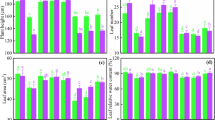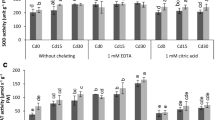Abstract
Increased cadmium (Cd) accumulation in soils has led to tremendous environmental problems, with pronounced effects on agricultural productivity. Present study investigated the effects of Cd stress imposed at various concentrations (0, 75, 150, 225, 300, 375 μM) on antioxidant activities, reactive oxygen species (ROS), Cd accumulation, and productivity of two maize (Zea mays L.) cultivars viz., Run Nong 35 and Wan Dan 13. Considerable variations in Cd accumulation and in behavior of antioxidants and ROS were observed under Cd stress in both maize cultivars, and such variations governed by Cd were concentration dependent. Exposure of plant to Cd stress considerably increased Cd concentration in all plant parts particularly in roots. Wan Dan 13 accumulated relatively higher Cd in root, stem, and leaves than Run Nong 35; however, in seeds, Run Nong 35 recorded higher Cd accumulation. All the Cd toxicity levels starting from 75 μM enhanced H2O2 and MDA concentrations and triggered electrolyte leakage in leaves of both cultivars, and such an increment was more in Run Nong 35. The ROS were scavenged by the enhanced activities of superoxide dismutase, peroxidase, catalase, ascorbate peroxidase, and glutathione peroxidase in response to Cd stress, and these antioxidant activities were higher in Wan Dan 13 compared with Run Nong 35 at all Cd toxicity levels. The grain yield of maize was considerably reduced particularly for Run Nong 35 under different Cd toxicity levels as compared with control. The Wan Dan 13 was better able to alleviate Cd-induced oxidative damage which was attributed to more Cd accumulation in roots and higher antioxidant activities in this cultivar, suggesting that manipulation of these antioxidants and enhancing Cd accumulation in roots may lead to improvement in Cd stress tolerance.




Similar content being viewed by others
References
Alscher RG, Erturk N, Heath LS (2002) Role of superoxide dismutases (SODs) in controlling oxidative stress in plants. J Exp Bot 53:1331–1341
Asada K (1992) Ascorbate peroxidase-a hydrogen peroxide scavenging enzyme in plants. Physiol Plant 85:235–241
Bachir DM, Wu FB, Zhang GP, Wu HX (2004) Genotypic difference in effect of cadmium on development and mineral concentrations of cotton. Commun Soil Sci Plant 35:285–99
Beers RF, Sizer IW (1952) A spectrophotometric method for measuring the breakdown of hydrogen peroxide by catalase. J Biol Chem 95:133–140
Chen A, Zeng G, Chen G, Liu L, Shang C, Hu X, Lu L, Chen M, Zhou Y, Zhang Q (2014) Plasma membrane behavior, oxidative damage, and defense mechanism in Phanerochaete chrysosporium under cadmium stress. Process Biochem 49:589–598
Chien HF, Wang JW, Lin CC, Kao CH (2001) Cadmium toxicity of rice leaves is mediated through lipid peroxidation. Plant Growth Regul 33:205–13
Cho UH, Seo NH (2005) Oxidative stress in Arabidopsis thaliana exposed to cadmium is due to hydrogen peroxide accumulation. Plant Sci 168:113–120
Ci D, Jiang D, Dai T, Qi J, Cao W (2009) Effects of cadmium on plant growth and physiological traits in contrast wheat recombinant inbred lines differing in cadmium tolerance. Chemosphere 77:1620–1625
Cobbett CS, May MJ, Howden R, Rolls B (1998) The glutathione deficient cadmium-sensitive mutant, cad 2-1, of Arabidopsis thaliana is deficient in gamma-glutamylcysteine synthetase. Plant J 16:73–78
Daud MK, Variath MT, Ali S, Najeebullah, Jamil M, Hayat Y, Dawood M, Khan MA, Zaffar M, Cheema SA, Tong XH, Zhu S (2009) Cadmium-induced ultra-morphological and physiological changes in leaves of two transgenic cotton cultivars and their wild relative. J Hazard Mater 168:614–625
De Vos C, Schat HM, De Waal MA, Vooijs R, Ernst W (1991) Increased resistance to copper-induced damage of the root plasma membrane in copper tolerant Silene cucubalus. Physiol Plant 82:523–528
Ekmekci Y, Tanyolac D, Ayhan B (2008) Effects of cadmium on antioxidant enzyme and photosynthetic activities in leaves of two maize cultivars. J Plant Physiol 165:600–611
Fahad S, Hussain S, Khan F, Wu C, Saud S, Hassan S et al (2015a) Effects of tire rubber ash and zinc sulfate on crop productivity and cadmium accumulation in five rice cultivars under field conditions. Environ Sci Pollut Res. doi:10.1007/s11356-015-4518-3
Fahad S, Hussain S, Saud S, Hassan S, Darakhshan, Chen Y et al (2015b) Grain cadmium and zinc concentrations in maize influenced by genotypic variations and zinc fertilization. Clean Soil Air Water. doi:10.1002/clen.201400376
Faize M, Burgos L, Faize L, Piqueras A, Nicolas E, Barba-Espin G, Clemente-Moreno MJ, Alcobendas R, Artlip T, Hernandez JA (2011) Involvement of cytosolic ascorbate peroxidase and Cu/Zn-superoxide dismutase for improved tolerance against drought stress. J Exp Bot 62:2599–2613
Gale F, Jewison M, Hansen J (2014) Prospects for China’s Corn Yield Growth and Imports. United States. Department of Agriculture Economic Research Service, Washington DC
Grant CA, Bailey LD, McLaughlin MJ, Singh BR (1999) Management factors which influence cadmium concentration in crops. In: McLaughlin MJ, Singh BR (eds) Cadmium in Soils and Plants. Kluwer Academic Publishers, Dordrecht, pp 151–198
Greger M, Lofstedt M (2003) Comparison of uptake and distribution of cadmium in different cultivars of bread and durum wheat. Crop Sci 44:501–507
Guo TR, Zhang GP, Zhang YH (2007) Physiological changes in barley plants under combined toxicity of aluminum, copper and cadmium. Colloids Surf B: Biointerfaces 57:182–188
Hegedus A, Erdei S, Horvath G (2001) Comparative studies of H2O2 detoxifying enzymes in green and greening barley seedlings under cadmium stress. Plant Sci 160:1085–93
Horst WJ (1995) The role of apoplast in aluminium toxicity and resistance of higher plants: a review. Z Pflanzenernaehr Bodenkd 158:419–28
Hu YL, Ge Y, Zhang CH, Ju T, Cheng W (2009) Cadmium toxicity and translocation in rice seedlings are reduced by hydrogen per oxide pretreatment. Plant Growth Regul 59:51–61
Jensen P, Adalsteinsson S (1989) Effects of copper on active and passive Rb + influx in roots of winter wheat. Physiol Plant 75:195–200
John MK, Van Laerhoven CJ (1976) Differential effects of cadmium on lettuce varieties. Environ Pollut 10:163–73
Karpinski S, Reynolds H, Karpinska B, Wingsle G, Creissen G, Mullineaux P (1999) Systemic signaling and acclimation in response to excess excitation energy in Arabidopsis. Plant Sci 284:654–6577
Khaliq A, Aslam F, Matloob A, Hussain S, Geng M, Wahid A, Rehman H (2015a) Seed priming with selenium: consequences for emergence, seedling growth, and biochemical attributes of rice. Biol Trace Elem Res. doi:10.1007/s12011-015-0260-4
Khaliq A, Zia-ul-Haq M, Ali F, Aslam F, Matloob A, Navab A, Hussain S (2015b) Salinity tolerance in wheat cultivars is related to enhanced activities of enzymatic antioxidants and reduced lipid peroxidation. Clean Soil Air Water. doi:10.1002/clen.201400854
Khan NA, Samiullah SS, Nazar R (2007) Activities of antioxidative enzymes, sulphur assimilation, photosynthetic activity and growth of wheat (Triticum aestivum) cultivars differing in yield potential under cadmium stress. J Agron Crop Sci 193:435–44
Kumar P, Tewari RK, Sharma PN (2007) Cadmium enhances generation of hydrogen peroxide and amplifies activities of catalase, peroxidases and superoxide dismutase in Maize. J Agron Crop Sci 194:72–80
Lacan D, Baccou JC (1998) High levels of antioxidant enzymes correlate with delayed senescence in nonnetted fruits. Planta 204:377–382
Liu H, Hussain S, Peng S, Huang J, Cui K, Nie L (2014) Potentially toxic elements concentration in milled rice differ among various planting patterns. Field Crop Res 168:19–26
Mahmood T, Gupta KJ, Kaiser WM (2009) Cd stress stimulates nitric oxide production by wheat roots. Pak J Bot 41:1285–1290
Marchiol L, Leita L, Martin M, Peressotti ZG (1996) Physiological responses of two soybean cultivars to cadmium. J Environ Qual 25:562–566
McLaughlin MJ, Williams CMJ, McKay A, Kirkham R, Gunton J, Jackson KJ et al (1994) Effect of cultivar on uptake of cadmium by potato-tubers. Aust J Agric Res 45:1483–95
Metwally A, Safronova VI, Belimov AA, Dietz KJ (2005) Genotypic variation of the response to cadmium toxicity in Pisum sativum L. J Exp Bot 409:167–78
Meuwly P, Rauser WE (1992) Alteration of thiol pools in roots and shoots of maize seedlings exposed to cadmium: adaptation and developing cost. Plant Physiol 99:8–15
Mobin M, Khan NA (2007) Photosynthetic activity, pigment composition and antioxidative response of two mustard (Brassica juncea L.) cultivars differing in photosynthetic capacity subjected to cadmium stress. J Plant Physiol 164:601–610
Noctor G, Foyer CH (1998) Ascorbate and glutathione: keeping active oxygen under control. Ann Rev Plant Biol 49:249–79
Pal M, Horvath E, Janda T, Paldi E, Szalai G (2005) Cadmium stimulates the accumulation of salicylic acid and its putative precursors in maize (Zea mays) plants. Physiol Plant 125:356–364
Sandalio LM, Dalurzo HC, Gómez M, Romero-Puertas MC, Río LA (2001) Cadmium-induces changes in the growth and oxidative metabolism of pea plants. J Exp Bot 52:2115–2126
Schutzendubel A, Polle A (2002) Plant responses to abiotic stress: heavy metal-induced oxidative stress and protection by mycorrhization. J Exp Bot 53:1351–1365
Stewert RC, Bewley JD (1980) Lipid peroxidation associated with accelerated aging of soybean axes. Plant Physiol 65:245–248
Sun Y, Zhou Q, Diao C (2008) Effects of cadmium and arsenic on growth and metal accumulation of Cd-hyperaccumulator Solanum nigrum L. Bioresour Technol 99:1103–1110
Tiryakioglua M, Ekerb S, Ozkutluc F, Hustedd S, Cakmak I (2006) Antioxidant defense system and cadmium uptake in barley genotypes differing in cadmium tolerance. J Trace Elem Med Biol 20:181–189
Wang J, Chen C (2009) Biosorbents for heavy metals removal and their future. Biotechnol Adv 27:195–226
Wang M, Zou J, Duan X, Jiang W, Liu D (2007) Cadmium accumulation and its effects on metal uptake in maize (Zea mays L.). Bioresour Technol 98:82–88
Wu F, Zhang G, Dominy P, Wu H, Bachir DML (2007) Differences in yield components and kernel Cd accumulation in response to Cd toxicity in four barley genotypes. Chemosphere 70:83–92
Xu X, Liu C, Zhao X, Li R, Deng W (2014) Involvement of an antioxidant defense system in the adaptive response to cadmium in maize seedlings (Zea mays L.). Bull Environ Contam Toxicol 93:618–624
Zheng M, Tao Y, Hussain S, Jiang Q, Peng S, Huang J, Cui K, Nie L (2015) Seed priming in dry direct-seeded rice: consequences for emergence, seedling growth and associated metabolic events under drought stress. Plant Growth Regul. doi:10.1007/s10725-015-0083-5
Zhou WB, Qiu BS (2005) Effects of cadmium hyper accumulation on physiological characteristics of Sedum alfredii Hans (Crassulaceae). Plant Sci 169:737–745
Acknowledgment
This work was financially supported by the National Science Foundation (No. 31271673) and Special Fund for Agro-scientific Research in the Public Interest (No. 201503127). The authors are thankful to Chongqing Key Laboratory of Crop Quality Improvement at College of Agronomy and Biotechnology, Southwest University, Chongqing, China.
Author information
Authors and Affiliations
Corresponding author
Additional information
Responsible editor: Elena Maestri
Rights and permissions
About this article
Cite this article
Anjum, S.A., Tanveer, M., Hussain, S. et al. Cadmium toxicity in Maize (Zea mays L.): consequences on antioxidative systems, reactive oxygen species and cadmium accumulation. Environ Sci Pollut Res 22, 17022–17030 (2015). https://doi.org/10.1007/s11356-015-4882-z
Received:
Accepted:
Published:
Issue Date:
DOI: https://doi.org/10.1007/s11356-015-4882-z




